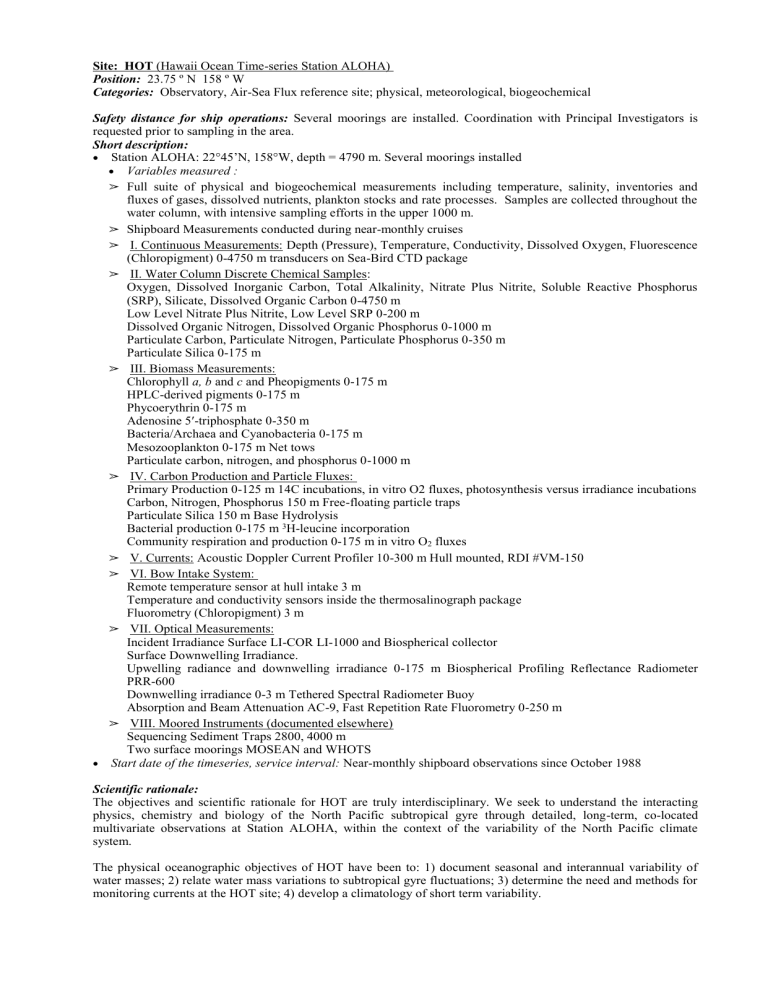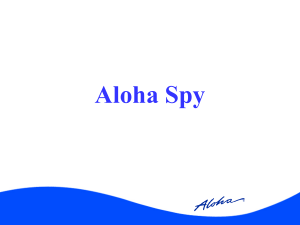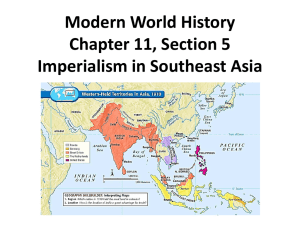HOT_ALOHA_Mar05

Site: HOT (Hawaii Ocean Time-series Station ALOHA)
Position: 23.75 º N 158 º W
Categories: Observatory, Air-Sea Flux reference site; physical, meteorological, biogeochemical
Safety distance for ship operations: Several moorings are installed. Coordination with Principal Investigators is requested prior to sampling in the area.
Short description:
Station ALOHA: 22°45’N, 158°W, depth = 4790 m. Several moorings installed
Variables measured :
➢
Full suite of physical and biogeochemical measurements including temperature, salinity, inventories and fluxes of gases, dissolved nutrients, plankton stocks and rate processes. Samples are collected throughout the water column, with intensive sampling efforts in the upper 1000 m.
➢
➢
Shipboard Measurements conducted during near-monthly cruises
I. Continuous Measurements: Depth (Pressure), Temperature, Conductivity, Dissolved Oxygen, Fluorescence
(Chloropigment) 0-4750 m transducers on Sea-Bird CTD package
➢
II. Water Column Discrete Chemical Samples:
Oxygen, Dissolved Inorganic Carbon, Total Alkalinity, Nitrate Plus Nitrite, Soluble Reactive Phosphorus
(SRP), Silicate, Dissolved Organic Carbon 0-4750 m
Low Level Nitrate Plus Nitrite, Low Level SRP 0-200 m
Dissolved Organic Nitrogen, Dissolved Organic Phosphorus 0-1000 m
Particulate Carbon, Particulate Nitrogen, Particulate Phosphorus 0-350 m
Particulate Silica 0-175 m
➢
III. Biomass Measurements:
Chlorophyll a, b and c and Pheopigments 0-175 m
HPLC-derived pigments 0-175 m
Phycoerythrin 0-175 m
Adenosine 5′-triphosphate 0-350 m
Bacteria/Archaea and Cyanobacteria 0-175 m
Mesozooplankton 0-175 m Net tows
Particulate carbon, nitrogen, and phosphorus 0-1000 m
➢
IV. Carbon Production and Particle Fluxes:
Primary Production 0-125 m 14C incubations, in vitro O2 fluxes, photosynthesis versus irradiance incubations
Carbon, Nitrogen, Phosphorus 150 m Free-floating particle traps
Particulate Silica 150 m Base Hydrolysis
Bacterial production 0-175 m 3 H-leucine incorporation
Community respiration and production 0-175 m in vitro O
2
fluxes
➢
V. Currents: Acoustic Doppler Current Profiler 10-300 m Hull mounted, RDI #VM-150
➢
VI. Bow Intake System:
Remote temperature sensor at hull intake 3 m
Temperature and conductivity sensors inside the thermosalinograph package
Fluorometry (Chloropigment) 3 m
➢
VII. Optical Measurements:
Incident Irradiance Surface LI-COR LI-1000 and Biospherical collector
Surface Downwelling Irradiance.
Upwelling radiance and downwelling irradiance 0-175 m Biospherical Profiling Reflectance Radiometer
PRR-600
Downwelling irradiance 0-3 m Tethered Spectral Radiometer Buoy
Absorption and Beam Attenuation AC-9, Fast Repetition Rate Fluorometry 0-250 m
➢
VIII. Moored Instruments (documented elsewhere)
Sequencing Sediment Traps 2800, 4000 m
Two surface moorings MOSEAN and WHOTS
Start date of the timeseries, service interval: Near-monthly shipboard observations since October 1988
Scientific rationale:
The objectives and scientific rationale for HOT are truly interdisciplinary. We seek to understand the interacting physics, chemistry and biology of the North Pacific subtropical gyre through detailed, long-term, co-located multivariate observations at Station ALOHA, within the context of the variability of the North Pacific climate system.
The physical oceanographic objectives of HOT have been to: 1) document seasonal and interannual variability of water masses; 2) relate water mass variations to subtropical gyre fluctuations; 3) determine the need and methods for monitoring currents at the HOT site; 4) develop a climatology of short term variability.
Chemistry and biology are inextricably linked in the objectives of HOT, framed within the Joint Global Ocean
Fluxes Study. Central objectives of the HOT program have been to estimate the annual air-to-sea flux of carbon dioxide, and develop an understanding of the climatology of biogeochemical rates and processes, including microbial community structure, primary and export production, and nutrient inventories. Understand how the seasonal and interannual variability of water masses relates to biogeochemical fluxes. Understand the time-varying processes that control carbon, nitrogen, and phosphorus cycling in the ocean. Relate biogeochemical fluxes to subtropical gyre fluctuations and ocean-atmosphere forcings. Develop a climatology of short-term variability in chemical, and biological processes in subtropical ocean ecosystems.
After 16 years, we have made significant progress on all of these, however we now know that decadal variability is as important as interannual variability. The major impediments have been limited spatial and high frequency temporal coverage to help define the frequency and spatial variability of the physical and biogeochemical signals that we’ve observed.
Groups / P.I.s /labs /countries involved / responsible:
Most of the funding for HOT is provided by the US National Science Foundation, with significant contributions from the State of Hawaii. The PIs of the “core” Hawaii Ocean Time-series are David Karl and Roger Lukas of the
University of Hawaii. Other PIs include Michael Landry (SIO), Robert Bidigare (UH), R. Letelier (OSU), and J.
Dore (UH). There are also numerous ancillary projects and investigators that take advantage of the core logistics, many of which contribute to the overall objectives of HOT. Ship support is provided by the US UNOLS.
Status:
operating;An observatory framework has been established at Station ALOHA, including two surface moorings
that were deployed at the edges of the 6 nm radius circle that defines the station. These moorings, MOSEAN and
WHOTS, are documented separately. time horizon / long-term plans: Indefinite funding status, source of funding: A renewal proposal for funding through 2008 was granted.
Technology:
moored / autonomous and ship-based sensors
SST: Remote temperature sensor at hull intake 3 m
Profile measurements: Ship-based Sea-Bird CTD continuous profiler 0-4750 m.
A vertical profiler will be implemented to resolve high frequency temporal dynamics in upper ocean plankton rate processes and biomass inventories. This vertical profiler is intended to complement the existing autonomous sampling devices (moorings) and the monthly shipboard sampling strategy. Eventually, we hope to provide an acoustic coupling of the existing moorings with subsurface instrumentation, bringing data back in near real-time, and enabling conditional sampling strategies. An autonomous glider has been maintained near ALOHA by UW scientists starting in late 2004 to measure spatial variations of temperature, salinity, dissolved oxygen and currents. We will try to maintain that effort after the project is completed during July 2005.
Data policy: delayed mode data (Hydrographic data and other cruise data) public available, see links below
Data management:
Satellite data collection system: Ocean color and spectral imaging operated by OSU including use of SEAWIFS,
MODIS, AVHRR
data processing and distribution system: As a general rule, we post our CTD data to our web site within one month of each cruise with preliminary quality control, and biogeochemical analyses are quality controlled and publicly available within a year of the time of collection.
Societal value / Users / customers:
The primary societal value of HOT has been to significantly advance our understanding of North Pacific subtropical gyre climate, and the impacts of climate variability on the ecosystem and its role in the carbon cycle. The HOT program has set an outstanding example for online sharing of observations and derived information. Thousands of users have downloaded our data resulting in hundreds of publications in peer-reviewed literature sources.
Role in the integrated global observing system:
Station ALOHA observations provide a high-quality calibration point for basin-scale maps of salinity (i.e. derived from Argo floats), as well as a suite of other variables, such as carbon inventories and nutrients. ALOHA is now an air-sea flux reference point. ALOHA provides a strong logistical and scientific framework for ocean technology research and development. ALOHA provides an important calibration/validation point for models of biogeochemical-physical interactions.
Contact Person:
for enquiry about addition of instrumentation or sensors to the site or for possible ancillary measurements during cruises to the site: David M. Karl and Roger Lukas (UH), hahana.soest.hawaii.edu/hot/crequest/main.html
for information about the site or data : dataman@soest.hawaii.edu
Links / Web-sites:
for Project information: kela.soest.hawaii.edu/ALOHA www.soest.hawaii.edu/HOT_WOCE hahana.soest.hawaii.edu/hot/hot.html
hahana.soest.hawaii.edu/hot/hale-aloha picasso.oce.orst.edu/ORSOO/hawaii
for data access: www.soest.hawaii.edu/HOT_WOCE/ftp.html
(Cruise data) uop.whoi.edu/projects/WHOTS/whotsdata.htm
(WHOTS Buoy data) http://www.pmel.noaa.gov/co2/moorings/hot/data_158w_all.htm
(HALE-ALOHA/MOSEAN CO2 data) http://www.opl.ucsb.edu/mosean/realtime_hi.html
(HALE-ALOHA/MOSEAN Buoy data)
Compiled by: Fernando Santiago-Mandujano and Matthew Church (March 2005)
Figure 1: a) Time series of monthly rainfall minus evaporation over the central North Pacific. b) Time series of the first two
EOFs of winter net freshwater flux over the North Pacific. The percentage of total variance accounted for by each EOF is indicated. c) Time series of salinity anomaly versus potential density.
The scale along the right axis indicates the mean depth (m) of the corresponding isopycnal surface. The mean salinity profile is given along the left. d) Time series of layer-averaged salinity for the salinity maximum layer and the main thermocline.
Light lines connect individual cruise values. Heavy lines are smoothing cubic splines. Closed circles are annual averages. Tick marks along the time axes indicate the timing of individual
HOT cruises. Interannual variations of rainfall near Hawaii are reflected in EOF1, and in the surface layer salinity at ALOHA.
The decadal time scale North
Pacific rainfall variations of
EOF2 correspond to the variations of upper pycnocline salinity with a lag of 1-2 years, depending on depth.
(Figure reproduced from Lukas, R. 2001. Freshening of the upper thermocline in the North Pacific subtropical gyre associated with decadal changes of rainfall. Geophysical Research Letters, V. 28, No. 18, 3485-3488.)
Figure 2:
Interannual variability and trends in pCO2 and the sea-air flux of CO2 at Station ALOHA. a (top) , Cruise mean values and linear trends in pCO2. The blue circles indicate atmospheric data while the red circles represent oceanic surface water concentrations calculated from DIC and TA. b (bottom) , Monthly flux of CO2 from ocean to atmosphere. The red diamonds represent the flux interpolated to the fifteenth day of each month and the solid black line indicates the linear trend in flux. Extrapolating the converging trend lines suggest the region will cease acting as a sink for atmospheric CO2 by
2008.
(Figure reproduced from Dore, J. E., R.
Lukas, D. W. Sadler and D. M. Karl. 2003.
Climate-driven changes to the atmospheric
CO2 sink in the subtropical North Pacific
Ocean. Nature, 424: 754-757).







